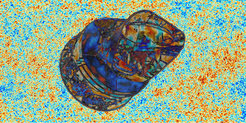Planck – mission accomplished
The Planck satellite mission to measure the cosmic microwave background radiation – the echo of the Big Bang – was completed in September 2020 with the publication of the final set of publications. In addition to groundbreaking insights into cosmology, the ESA mission also provided a large number of astrophysical results. A brief review.

Launched on 14 May 2009 in Kourou in French Guyana, the Planck telescope measured the microwave radiation of the cosmos between 3 July 2009 and 3 October 2013. It was placed in a Lissajous orbit around the second Lagrange point of the Sun-Earth system, 1.5 million kilometres – or one percent – further away from the Sun than the Earth. Over the course of more than four years, the telescope scanned the entire sky five times in nine frequency bands between 30 and 857 GHz. By January 2012, the helium-3 coolant ran out and only the detectors between 30 and 70 GHz remained functional. As of October 3, 2013, the satellite was deactivated step by step, sent into a park orbit around the Sun, and finally shut down on October 23, 2013.
The Planck data, sent daily to Earth, provided high-resolution images of the sky in the nine different frequency bands as well as seven polarization images of the sky. This data was used to distinguish the various sources of cosmic microwave radiation according to their different origins. The primary goal of the mission was to precisely measure the thermal background radiation of the Big Bang, whose tiny temperature variations provide information about the age, size, composition, and origin of the cosmos. In addition, countless other sources of microwave radiation detected by Planck led to a rich scientific harvest. Planck provided spectacular images of galactic dust clouds, whose polarization indicates the presence of intertwined magnetic fields. More than a thousand clusters of galaxies were measured by Planck, some for the first time. Planck was even able to detect planets and smaller objects in the solar system.
The rich scientific yield of the Planck mission is extensive. In 156 publications and on 4627 pages, the Planck Collaboration has described the cosmological, astrophysical and technical results of the mission. To date, these have been cited almost 50,000 times by other research papers. The highest impact, with almost 20,000 citations, was achieved by the publications on the determination of the cosmic parameters – not surprisingly, since this was the mission goal – as well as the publications on investigating the inflationary phase at the beginning of cosmic time, with about 4,500 citations. But also papers on astrophysical objects, statistical tests of the cosmic Standard Model, galactic and primordial magnetic fields, gravitational lensing and many more have left clear marks in science, proven by almost 25,000 citations. As the data from the mission is publicly available, already there are almost 2,000 other publications on Planck written outside the collaboration.
The Planck mission was established in 1996 and has now come to an end a quarter of a century later, in September 2020, with the publication of the final set of publications. The Max Planck Institute for Astrophysics (MPA) in Garching has been involved in the mission since 1999 with the MPA Planck Analysis Centre (MPAC). Originally set up by Matthias Bartelmann, the MPAC developed software for the scientific simulation and data processing of the mission. After Matthias Bartelmann accepted a call to the University of Heidelberg, Torsten Enßlin took over management of the centre in 2003.












